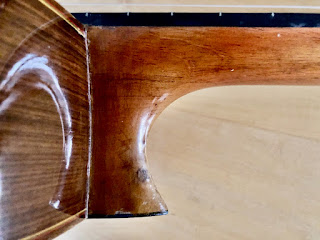A bit odd to start with a label as this is not a luthiers'
label to our believe but most likely a guitar and other
musical accessoires supplier who had these instruments
built elsewhere. Union Musicales Espanola had their
shops in different Spanish cities. Price: € 1250,-
Not a well known headstock for me but some details might
point to a Barcelona based luthier: The Juan Estruch company.
Recently I stumbled onto a 1970 guitar with the same headstock.
About the age of this guitar one can conclude that the later
ugly polyurethane finish is not present on the soundboard
but is there on the neck, sides and back.
In the lower left there is some damage on the back and
after a good night sleep I decided to make some inserts
for the cracks there. As it has to be levelled afterwards
the back as a whole will be refinished.
The yellow, red and green bindings are typical for Estruch
so possibly another Juan Estruch model. Contact with the
Estruch company indeed learnt that we are dealing with
a genuine Juan Estruch, one of the oldest guitar companies
in Spain though there are no "Estruch" named luthiers at
work anymore in the factory nowadays. Another luthier
most likely bought the name and went on. On the other
hand, several luthiers learnt their craft at the Estruch
workforce among them Jose Grau, Jose Farre, Manuel
Condal and Antonio Picado. Also the later Antigua Casa
Gol is one of them. Closely related to the Estruch
company is the Taurus Workforce. So a lot of different
luthiers could have been responsible for the building
of this guitar.
This headform resembles the much copied Ignacio Fleta
head but not exactly. That might give more direction towards
the luthier who constructed this guitar. But on the other hand
several details were more than often copied especially by the
luthiers from Barcelona who worked for Estruch. The multi
coloured bindings, Estruch is known for. Inlay in the bridge
and even rosettes often were made by independent factories
who supplied several luthiers in their country.
Nice clean rollers and refreshed frets. Alass this guitar
has to be refretted as the neck is showing a serious backbow
which I have never found on a classical guitar until now!
And the only way to make a proper correction is to treat
the fingerboard by shaving it. In a most worst case the
fingerboard could have been replaced after having lined
out the neck. Most of the time not necessary.
A nice rosette and a spruce soundboard that is "crack" free.
And a matching inlay in the string tie block.
Fustero tuners that are in good condition.
Some spots on the outer neckblock but nothing fundamental.
In fact the case might give an idea about the age of this
guitar. Anyway a lot to be investigated still but a start
has been made by judging its' sound: Someone hightened
the bridgebone by putting some paper under the bridge
bone. A disaster for a good sound. Moreover the bridge-
bone was broken but that has been solved already.
I don't know the brand of strings but to my opinion
this guitar will sound even better with Savarez Corum.
The volume it can provide is already there now!
Here the label on the inside of the case is presented.
Another typical move on the Concerto series of Estruch
was the use of an ebony veneer layer on the outer heel.
And the multi coloured bindings of course. A short
E-mail contact between the Estruch company and me
confirmed my thoughts about the origin: Juan Estruch.
Here the facade of the UME shop in Girona is presented.
We were curious to learn what they could tell about a part of
the history of this company. The guy in charge wasn't very
helpful. "All those UME labelled guitars of the past are
crap" was all he stated. I showed him some pictures of the
this high end Estruch guitar but he wasn't convinced at all.
That made me think that you always have to understand
who is the person in front of you. He acted completely
wrong and what is more, quite unfriendly. A few days
before visiting Girona we visited the workshop of Antonio
Picado and that meeting was quite the opposite!













